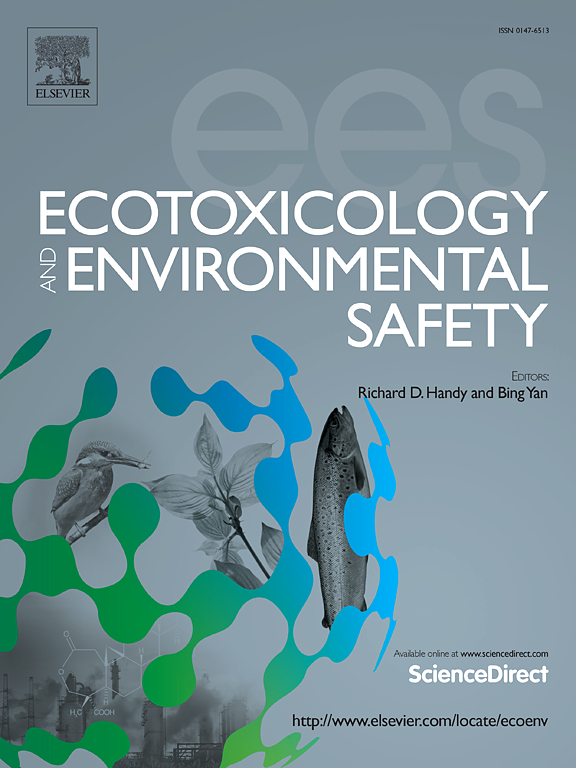Integrating machine learning and reliability analysis: A novel approach to predicting heavy metal removal efficiency using biochar
IF 6.2
2区 环境科学与生态学
Q1 ENVIRONMENTAL SCIENCES
引用次数: 0
Abstract
Soil contamination with heavy metals (HMs) presents critical environmental and public health risks due to their long-term persistence and tendency to bioaccumulate. Biochar has gained recognition as an effective amendment for HM immobilization, owing to its cost-effectiveness, environmental sustainability, and multifunctional properties. Nevertheless, consistent removal efficiency remains challenging to achieve due to the inherent variability of biochar and its interactions with complex environmental factors. This research introduces an advanced machine learning (ML) framework, utilizing deep forest (DF) algorithms, to predict and optimize the efficiency HM removal through biochar applications. The framework addresses key challenges by employing data imputation to manage missing information, data augmentation to overcome limitations of small datasets, and reliability analysis to assess predictive uncertainties, thereby improving the model’s reliability and generalization capability. The findings reveal that the DF model surpasses conventional ML approaches, achieving a testing dataset coefficient of determination (R²) of 0.88. Additionally, probabilistic reliability analysis offers valuable insights into the likelihood of reaching various levels of remediation efficiency (RE). For lower RE thresholds, such as 20–30 %, the model predicts a high probability (over 80 %) of substantial HM removal, confirming biochar’s effectiveness in mitigating contamination. However, as the target RE thresholds rise to moderate levels (50–70 %), the probability drops significantly (to below 5 %), highlighting the increasing difficulty of achieving higher remediation efficiencies. Furthermore, this study has developed an accessible and intuitive web-based application, enabling engineers to input relevant parameters and receive immediate predictive outputs, thus facilitating the practical application of advanced ML models in real-world scenarios.
整合机器学习和可靠性分析:一种预测生物炭去除重金属效率的新方法
土壤重金属污染由于其长期的持久性和生物积累的趋势,对环境和公众健康造成了严重的危害。由于其成本效益、环境可持续性和多功能特性,生物炭已被公认为是HM固定的有效修正。然而,由于生物炭的内在可变性及其与复杂环境因素的相互作用,实现一致的去除效率仍然具有挑战性。本研究引入了一种先进的机器学习(ML)框架,利用深度森林(DF)算法来预测和优化生物炭应用对HM的去除效率。该框架通过使用数据输入来管理缺失信息,使用数据增强来克服小数据集的限制,使用可靠性分析来评估预测不确定性,从而提高模型的可靠性和泛化能力,解决了关键挑战。结果表明,DF模型优于传统的ML方法,实现了0.88的测试数据集决定系数(R²)。此外,概率可靠性分析为达到不同级别的补救效率(RE)的可能性提供了有价值的见解。对于较低的可再生能源阈值,例如20-30 %,该模型预测了大量去除HM的高概率(超过80 %),证实了生物炭在减轻污染方面的有效性。然而,随着目标可再生能源阈值上升到中等水平(50-70 %),概率显著下降(低于5 %),这凸显了实现更高补救效率的难度越来越大。此外,本研究还开发了一个可访问且直观的基于web的应用程序,使工程师能够输入相关参数并获得即时的预测输出,从而促进了先进ML模型在现实场景中的实际应用。
本文章由计算机程序翻译,如有差异,请以英文原文为准。
求助全文
约1分钟内获得全文
求助全文
来源期刊
CiteScore
12.10
自引率
5.90%
发文量
1234
审稿时长
88 days
期刊介绍:
Ecotoxicology and Environmental Safety is a multi-disciplinary journal that focuses on understanding the exposure and effects of environmental contamination on organisms including human health. The scope of the journal covers three main themes. The topics within these themes, indicated below, include (but are not limited to) the following: Ecotoxicology、Environmental Chemistry、Environmental Safety etc.

 求助内容:
求助内容: 应助结果提醒方式:
应助结果提醒方式:


